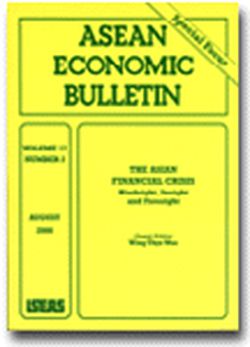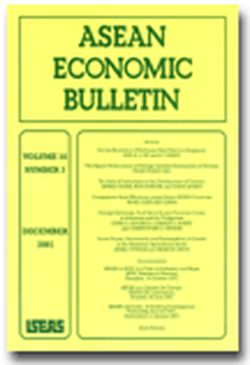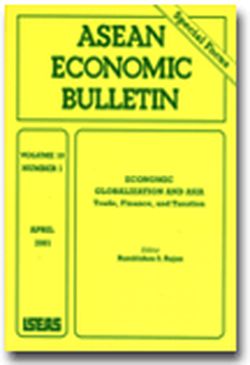ASEAN Economic Bulletin Vol. 15/3 (Dec 1998). Special Focus Issue on "Southeast Asia's Economic Crisis: Origins, Lessons, and the Way Forward".

Date of publication:
December 1998
Number of pages:
132
Code:
AE15/3
About the publication
Special focus on Southeast Asia's Economic Crisis: Origins, Lessons and the Way Forward, edited by H.W. Arndt and Hal Hill. Single copies of this issue of the Bulletin are not for sale. A book edition of the articles, entitled Southeast Asia's Economic Crisis: Origins, Lessons and the Way Forward, is available for sale.
Contents
-
Preliminary pages
-
1. An Overview of the Issues see abstractUntil 1997, the major challenge for a researcher working on Southeast Asia was to explain why most of the major economies had grown so quickly for so long. Now, the question is why and how the fortunes of some of these economies have been transformed so drastically. This paper introduces the major themes and issues which are addressed by the contributors: what has happened, why it has happened, what are the socioeconomic effects, and what are some of the broader policy and analytical implications of the crisis? The country papers examine developments in the six major economies of ASEAN, highlighting common challenges of national economic management in an ever more interdependent global and regional economy, and the very different effects and responses within the region. The thematic contributions focus on broader questions related to financial reform and regulation, poverty, exchange rate policy options, attempts to model the crisis and its aftermath, regional economic co-operation, and political economy issues related to the crisis.
-
2. The Indonesian Crisis see abstractThis article examines the causes of the crisis in Indonesia and seeks to explain why its effects have been so much more devastating than in the other ASEAN countries. Indonesia has had financial crises before but this one had a regional character: a sudden collapse of confidence of the footloose international short-term capital that took fright. The economic fundamentals were, in retrospect, much less stronger than they seemed. The private sector had gone on an investment spending spree, abetted by foreign loans made available at minimum security and prudence. However, the depth of the Indonesian crisis was largely attributable to political factors, political instability surrounding Soeharto, the impending succession, evident corruption, and repression of all political opposition. Critics also blamed the IMF for orthodox recipes which initially worsened the situation.
-
3. Swimming against the Tide: Crisis Management in Malaysia see abstractThe Philippines has avoided the worst consequences of a full-scale crisis because it had strong economic fundamentals, including a reformed financial sector at the onset of the regional crisis. This paper gives an account of the response of the Philippines to the baht collapse. The peso was floated shortly after the baht currency crisis. One year later, the Philippine economy was still in relatively good shape, but growth was slowing down and there was concern about the the consequences for the Philippines if the contagion spreads beyond Asia. The new Estrada Government stressed the need for further stringent budget cuts. The stock market continued to decline. The liberalization programme was kept in place, inflation remained moderate, and exports continued to show strong growth. However, the economy remains vulnerable if the crisis continues much longer.
-
4. The Philippine Economy in the Asian Crisis see abstractThe Philippines has avoided the worst consequences of a full-scale crisis because it had strong economic fundamentals, including a reformed financial sector at the onset of the regional crisis. This paper gives an account of the response of the Philippines to the baht collapse. The peso was floated shortly after the baht currency crisis. One year later, the Philippine economy was still in relatively good shape, but growth was slowing down and there was concern about the the consequences for the Philippines if the contagion spreads beyond Asia. The new Estrada Government stressed the need for further stringent budget cuts. The stock market continued to decline. The liberalization programme was kept in place, inflation remained moderate, and exports continued to show strong growth. However, the economy remains vulnerable if the crisis continues much longer.
-
5. The Asian Financial Crisis: Singaporeâs Experience and Response see abstractAlthough Singapore has a very open economy, both in the current and capital accounts, the impact of the crisis has not been as severe as in several less open regional economies; thus economic openness and globalization are not sufficient factors. Further, despite sound fundamental macroeconomic policies, Singapore did not escape the fallout from the regional crisis; thus these factors are insufficient insurance against overreactions and herd behaviour of currency traders and speculators. Finally, Singaporeâs policy response to the crisis is not to reject globalization and liberalization, but to undertake further reforms and restructuring to ensure international competitiveness.
-
6. Economic Crises and the Debt-Deflation Episode in Thailand see abstractA fixed exchange rate regime can create an illusion of a zero-exchange rate risk, while premature relaxation of capital controls can encourage over-borrowing in foreign currencies. Currency and maturity mismatching of Thai commercial banks generated their overexposure to external shocks. The export shortfall in 1996 and widening current account deficit raised doubts concerning the sustainability of the baht currency peg. With the baht succumbing to speculative attacks, the Bank of Thailand decided to float it on 2 July 1997. Without a nominal anchor and given the lack of policy credibility, the value of the baht fell by 56% through to January 1998. This large currency depreciation aggravated the foreign debt burden, causing a credit crunch, high interest rates, bankruptcy, and financial dis-intermediation. The loss of consumer and business confidence stemming from the expected recession exacerbated the contraction in investment and consumption. Until the exchange rate rebounds to a level determined by economic fundamentals, the economy will continue this debt-deflation episode.
-
7. Vietnam: Ready for Doi Moi II? see abstractCompared with its ASEAN neighbours, Vietnam appears to have weathered the Asian crisis quite well. Official statistics indicate a GDP growth rate of 6.6% for the first half of 1998; export growth remains positive, and the dong has depreciated by only 20% against the U.S. dollar. But the relatively favourable picture has more to do with controls than with sound economic fundamentals. In the absence of comprehensive reforms, the Vietnamese economy will gradually slide into a deeper recession. Influential interest groups, such as SOEs and their employees, hanker after a return to central planning. What is needed instead is a doi moi II, including measures to liberalize trade, strengthen the financial system, and promote transparency throughout the economy.
-
8. Exchange Rates in the East Asian Crisis see abstractThis paper looks at the recent history of East Asian exchange rate regimes in the context of the wider international discussion of exchange rates. It examines whether the exchange rate regimes were a cause of the crisis, or whether the crisis would have emerged under alternative exchange rate regimes. It focuses on the relationship between the exchange rate regime and the recovery process. It then asks whether exchange controls can help in maintenance of exchange rate and economic stability. The article concludes with a discussion of how the recent experience may affect future choice of exchange rate regimes.
-
9. The Crisis and Financial Sector Reform see abstractThe extreme disruption resulting from Asiaâs financial crisis demand a thorough reassessment of the standard models for financial sector reform. After reviewing a number of now discredited preconceptions about financial liberalization, such as that financial markets are self-regulating, or that foreign investors and credit-rating agencies are good at assessing risk, this paper explores some options that should be considered in planning for future financial systems development. These include: less ambitious economic growth targets; less reliance on debt finance and more on self-finance; insulating payment system functions from saving-investment functions; reinforcing capital-asset requirements with solvency reserve requirements; restricting some forms of capital inflows and requiring better disclosure of foreign borrowing; limiting bank secrecy rules and making banks more transparent; strengthening international co-ordination of prudential regulation and permitting direct intervention by regulatory authorities to deal with financial market manipulation.
-
10. Modelling the Crisis in Asia see abstractThis paper gives an overview of studies that have attempted to model the crisis in Asia. Although no model-based research predicted the crisis, modelling results have given useful insights into the cause of the crisis as well as the sectoral and macroeconomic adjustment to be expected following the crisis. Some alternative policy responses have also been simulated; these throw light on how to respond to the Asian crisis within and outside Asia.
-
11. The Impact of the Crisis on Poverty and Equity see abstractThis article serves three purposes: (l) it reviews the evidence on trends in urban and rural poverty in Southeast Asia in recent years; (2) it examines the available estimates of increases in poverty in Indonesia, the most severely affected economy; (3) in the light of this evidence, it looks at possible policy interventions, specifically for Indonesia, but also draws some more general conclusions for the ASEAN region.
-
12. Political Institutions and the Economic Crisis in Thailand and Indonesia see abstractThe economic crisis in Southeast Asia has not been driven only by factors such as pegged exchange rates, heavy short-term foreign borrowing, and hopelessly inadequate financial sector regulation; politics has also been important. Indeed, in any case where there is a massive loss of investor confidence it would be difficult for politics not to be involved. In arguing for some attention to be paid to political factors, this article seeks to focus on one particular variable: political structure. In both Thailand and Indonesia, political structure greatly compounded the task of responding to the crisis and thereby served to intensify the economic destruction even though this common problem originated in different ways and stemmed from different institutional problems.
-
13. ASEAN during the Crisis see abstractThis article examines the efforts that have been made by the Association of Southeast Asian Nations (ASEAN) as an institution to deal with the Asian crisis. At the national level, member countries have taken steps to strengthen supervision of banks, foster great transparency in financial transactions, and promote competition. At the bilateral level, ASEAN members have extended assistance to the most affected countries, especially Indonesia. At the international level, ASEAN members have collectively appealed to the advanced countries to keep their markets open, to be more accommodating in the renegotiation of debt, and to remember to protect the poor in their reform programmes. The article traces ASEAN initiatives at successive meetings, but concludes that existing economic co-operation programmes need to be widened in scope and deepened in commitments.
-
Index to Volume 15






